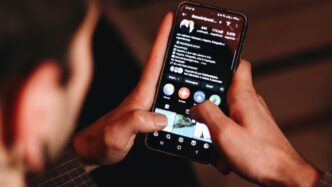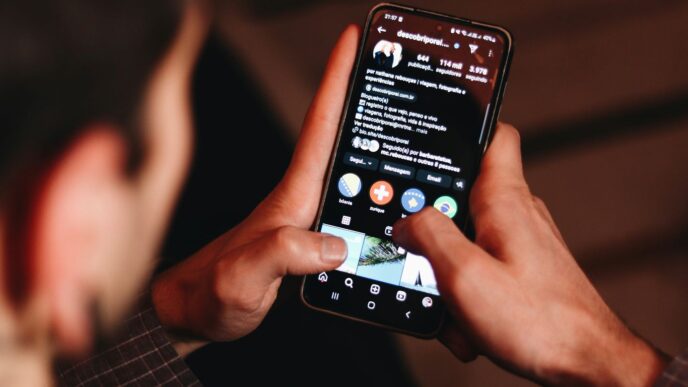It feels like every year, technology just keeps getting crazier, right? We’re seeing stuff come out that honestly sounds like it’s straight out of a sci-fi movie. From gadgets that help us stay healthy to ways to get around that are totally new, inventors are really busy. It’s exciting to think about what’s next, and 2025 looks like it’s going to be a big year for new invention ideas that could change how we do things. Let’s check out some of the coolest new invention ideas hitting the scene.
Key Takeaways
- Samsung’s Galaxy Ring is a new wearable for tracking health.
- Microsoft Copilot+ PCs bring AI features directly to computers.
- Joby is making electric planes that can take off and land vertically.
- Notpla uses seaweed to create packaging that’s better for the environment.
- GE has a new smoker for your kitchen counter.
1. Samsung Galaxy Ring
Okay, so you’ve probably heard the buzz about the Samsung Galaxy Ring. It’s not just another smartwatch trying to do everything; this little gadget is all about your health. Think of it as a super discreet way to keep tabs on your body’s signals without a bulky device on your wrist. It’s designed to track your sleep, heart rate, and activity levels, giving you insights that might be hard to catch otherwise.
Samsung is really aiming to make health tracking more accessible and less intrusive. The idea is that by wearing this ring, you get a constant stream of data that can help you understand your well-being better. It’s supposed to be comfortable enough to wear 24/7, even while you’re sleeping, which is key for accurate sleep tracking.
While Samsung hasn’t spilled all the beans yet, we’re expecting some pretty neat features. Based on what’s out there, here’s what we might see:
- Advanced Sleep Analysis: Going beyond just how long you slept, it could track sleep stages (light, deep, REM) and even detect things like snoring.
- Heart Health Monitoring: Continuous heart rate tracking and maybe even some basic ECG capabilities.
- Activity and Movement Tracking: Steps, calories burned, and general movement throughout the day.
- Wellness Insights: The ring will likely connect to an app that translates all this data into easy-to-understand advice for improving your health.
It’s a pretty exciting step for wearable tech, moving away from screens and towards more integrated, subtle health monitoring. We’re looking at a potential Winter 2026 release, and while the exact price isn’t set, it’s rumored to start around $399. It’s definitely one to watch if you’re into understanding your body better without the usual tech clutter. You can find more details about its anticipated features on Samsung’s health tech.
2. Microsoft Copilot+ PCs

Alright, let’s talk about Microsoft’s Copilot+ PCs. These aren’t just your average laptops; they’re built with a new kind of chip, called an NPU, that’s specifically designed to handle AI tasks right on the device. Think of it as giving your computer a dedicated brain for all things smart.
What does this mean for you? Well, it means things can get done faster and more privately. Instead of sending your data off to the cloud for processing, a lot of the heavy lifting happens locally. This is a pretty big deal for security and speed.
Microsoft is really pushing the idea that these PCs can help you with everyday tasks in new ways. They’re talking about features that can:
- Summarize long documents or email threads instantly.
- Generate images based on simple text descriptions.
- Help you recall information from your past computer use, like finding a specific file you worked on weeks ago.
- Translate languages in real-time during calls.
It’s like having a helpful assistant built right into your operating system. They’re aiming to make your computer work for you, taking care of the tedious stuff so you can focus on what matters. The whole idea is to make computing feel more intuitive and less like a chore. We’re still seeing how this all shakes out, but the potential for these AI-focused machines is pretty interesting.
3. Joby eVTOL Aircraft
Get ready for a new way to travel because flying cars, or rather, electric vertical takeoff and landing (eVTOL) aircraft, are getting closer to reality. Joby is one of the companies leading the charge in this exciting field. They’ve been working hard on their eVTOL design, which looks more like a sleek, quiet helicopter than a car, and it’s designed for carrying passengers.
The big goal here is to make short-to-medium distance air travel more accessible and convenient. Imagine skipping traffic jams by hopping into an air taxi. Joby’s aircraft is all-electric, meaning it’s quieter and better for the environment than traditional helicopters. They’ve already hit some major milestones, like completing the first flight of their hybrid electric model.
Here’s a quick look at what makes these aircraft stand out:
- Electric Propulsion: Uses electric motors for quieter, cleaner flights.
- Vertical Takeoff and Landing: Can take off and land like a helicopter, needing no runway.
- Passenger Capacity: Designed to carry multiple passengers, making it suitable for air taxi services.
Joby is working closely with the FAA to get all the necessary certifications, which is a huge step. They’ve even delivered a couple of their eVTOLs to Edwards Air Force Base, showing potential for military applications too. This technology could really change how we think about transportation in and around cities. You can find out more about their progress on the Joby Aviation website.
4. Notpla Seaweed Packaging
Plastic waste is a huge problem, right? It feels like everywhere you look, there’s another piece of plastic that’s going to stick around for ages. That’s where companies like Notpla come in, trying to offer a better way. They’re making packaging out of seaweed, which sounds pretty wild but actually makes a lot of sense.
Their main idea is to replace single-use plastics with materials that break down naturally. They’ve developed this stuff called Ooho, which is made from brown seaweed. It’s not just for big containers either; they’re using it for things like those little sauce packets you get with takeout. Imagine getting your fries and dipping sauce, and the container for the sauce just… disappears after you’re done. Pretty neat.
Notpla is really pushing this forward. They’ve already started using their packaging at places like Ikea’s cafes. Their big goal is to get rid of a billion single-use plastic items by the year 2030. That’s a massive target, but it shows they’re serious about making a difference.
Here’s a bit more about what makes their approach interesting:
- It’s Biodegradable: Unlike plastic, Notpla’s packaging breaks down naturally, meaning it won’t sit in a landfill or the ocean for hundreds of years.
- It’s Made from a Renewable Resource: Seaweed grows fast and doesn’t need much to thrive, making it a good sustainable option.
- It’s Versatile: They’re finding ways to use it for different types of food packaging, from drink coatings to sauce containers.
It’s still early days for this kind of material on a massive scale, but seeing companies like Notpla innovate with natural resources gives you a bit of hope for a less plastic-filled future.
5. GE Countertop Pellet Smoker

For those of us living in apartments or just wanting to smoke some ribs without a giant, outdoor setup, GE’s countertop pellet smoker is a pretty neat idea. It basically lets you do that slow, smoky cooking thing right on your kitchen counter, all year round. Think brisket or pulled pork, even when it’s snowing outside.
This thing is designed to make smoking accessible to more people. It uses pellets, which give that authentic smoky flavor, and it’s got smart features like app-connected probes so you can keep an eye on your food’s temperature from your phone. Plus, there’s a "keep warm" mode, which is super handy if dinner isn’t quite ready when you are.
Here’s a quick look at what makes it stand out:
- Compact Design: Fits on most kitchen countertops.
- Pellet Fuel: Provides real wood smoke flavor.
- Smart Connectivity: App control for temperature monitoring.
- Versatile Cooking: Capable of slow-cooking and smoking various meats.
- Keep Warm Function: Maintains food temperature until serving.
It’s one of those inventions that takes something traditionally done outdoors and brings it inside, making it way more convenient for everyday cooks.
6. Ray-Ban Smart Glasses
Okay, so remember when smart glasses first came out and they looked like something out of a sci-fi movie? Well, Ray-Ban is trying to change that whole vibe. They’ve teamed up with EssilorLuxottica to create smart glasses that actually look like, you know, regular Ray-Bans. They’ve managed to pack in a 12-megapixel camera, speakers that are open so you can still hear your surroundings, and even Meta AI voice assistance. It’s pretty wild to think you can just talk to your glasses to get things done.
They’re not just about looks, though. These things are selling. EssilorLuxottica has already moved two million pairs since late 2023, and they’re aiming to crank out ten million a year. That’s a pretty big jump, so they must be onto something.
Here’s a quick rundown of what they offer:
- Integrated Camera: Snap photos or record short videos without pulling out your phone.
- Open-Ear Audio: Listen to music, take calls, or use voice commands while staying aware of what’s happening around you.
- Voice Assistant: Access Meta AI for help with tasks, information, or just a quick chat.
- Stylish Design: Available in classic Ray-Ban frames, so you don’t have to sacrifice your look for tech.
It feels like we’re finally getting closer to smart glasses that people will actually want to wear every day. It’s still early days, but seeing a big name like Ray-Ban get involved makes you think this is more than just a fad.
7. WiTricity Wireless Charging Surfaces
Remember when charging your phone meant fumbling with cables in the dark? Those days are starting to feel pretty ancient, thanks to innovations like WiTricity. They’re developing wireless charging technology that goes beyond just a single charging pad. Imagine walking into your kitchen and your phone, your earbuds, or even your laptop just starts charging because you’ve placed it on the countertop or a desk. That’s the future WiTricity is building.
This isn’t just about convenience, though that’s a big part of it. It’s about creating a truly wire-free environment. Think about public spaces – cafes, airports, even your car. WiTricity’s system uses magnetic resonance to transfer power efficiently over a short distance. So, instead of hunting for an outlet, you just set your device down. It’s like magic, but it’s science.
Here’s a quick look at what makes it stand out:
- True Wireless Power: Devices charge simply by being placed on or near a charging surface, no precise alignment needed.
- Multi-Device Charging: A single charging surface can power multiple gadgets at once.
- Integration Potential: The technology can be built into furniture, vehicles, and building infrastructure.
While we’re still seeing this technology roll out more broadly, the potential is huge. It could mean fewer tangled cords cluttering our lives and a more integrated, effortless tech experience.
8. Pocketalk Voice-Activated Wearable Translators
Ever found yourself in a situation where you desperately needed to communicate but didn’t speak the language? It’s a common frustration, right? Well, Pocketalk is stepping in with a neat solution: voice-activated wearable translators. These little gadgets are designed to make real-time language translation happen right on your person, breaking down those awkward communication walls.
Imagine traveling abroad and being able to have a natural conversation with a local shopkeeper or asking for directions without fumbling with your phone. That’s the idea behind these translators. They’re built to be worn, so they’re always ready when you need them. The goal is to make cross-cultural communication feel less like a chore and more like a natural interaction.
While the exact specs can vary, here’s a general idea of what you might expect:
- Real-time Translation: Speak into the device, and it translates your words almost instantly into the chosen language.
- Two-Way Communication: It doesn’t just translate for you; it can translate what others are saying back to you.
- Multiple Languages: Most devices aim to support a wide range of languages, covering most common travel destinations.
- Wearable Design: Think small, discreet devices that can be clipped on or worn around the neck, keeping your hands free.
It’s not just for tourists, either. These could be super handy for international business meetings, helping healthcare professionals communicate with patients, or even just for connecting with people from different backgrounds in your own community. It’s about making the world feel a little smaller and more connected, one conversation at a time.
9. Lenovo ThinkBook Plus Gen 5 Hybrid
Okay, so imagine a laptop that can also be a tablet, and not in that flimsy way some do it. Lenovo’s ThinkBook Plus Gen 5 Hybrid is pretty wild. It’s basically two devices in one, and it actually won an award at CES 2025 for being so clever. You can use the screen and keyboard together like a normal laptop, which is great for typing up reports or whatever. But then, you can just pop the screen right off. Suddenly, you’ve got a full-blown tablet. Or, if you want to go even simpler, you can use the screen by itself as a standalone PC. It’s like having a few different gadgets all rolled into one, which could actually save you some desk space.
Here’s a quick look at how it works:
- Detachable Display: The main screen easily separates from the keyboard base.
- Dual Functionality: Use it as a traditional laptop or a tablet.
- Standalone Screen: The display can also function as a separate PC.
- Versatile Power: It runs on Windows, giving you access to all your usual software.
10. Air Up Scent-Flavor Water Bottle
Remember those juice boxes from when you were a kid? The ones that made your water taste like fruit punch or grape soda, but were still, you know, mostly water? Well, a German startup called Air Up has taken that idea and given it a modern, techy twist. This isn’t just another water bottle; it’s a whole experience designed to get you drinking more water without adding any sugar or artificial sweeteners.
How does it work? It’s pretty clever, actually. The bottle uses these little pods that you pop into the lid. When you drink, the pod releases a scent, and somehow, your brain tricks itself into thinking the water has a flavor. It’s all about retronasal olfaction – basically, how your sense of smell influences your perception of taste. It’s a neat trick that makes plain water way more interesting.
This whole concept really took off, especially with kids. It became a bit of a craze in UK schools back in 2024, which makes sense. Getting kids to drink enough water can be a challenge, and this offers a fun, healthier alternative to sugary drinks. Plus, it’s reusable, so it’s better for the planet than single-use plastic bottles.
Here’s a quick rundown of what makes it stand out:
- Scent Pods: These are the magic ingredient. They come in various flavors like lemon, orange, or even cola, and you just swap them out when you want a change.
- Retronasal Olfaction: The science behind it. The scent travels up the back of your throat to your olfactory receptors, making you perceive flavor.
- Sustainability: Reusable bottle, replaceable pods. It cuts down on waste compared to buying flavored drinks.
- Health Focus: Encourages hydration without added sugars or calories, which is a big win for anyone trying to be healthier.
What’s Next for Innovation?
So, there you have it – ten ideas that could really shake things up in 2025. It’s pretty wild to think about what’s possible, right? From making our homes smarter and our lives healthier to finding new ways to care for the planet, the future is looking pretty interesting. This list is just a starting point, of course. The real magic happens when you take these sparks and run with them, figuring out how to make them a reality. Who knows, maybe one of these ideas will be the next big thing everyone’s talking about. Keep thinking, keep creating, and let’s see what amazing things we can build together.
Frequently Asked Questions
What makes a product ‘innovative’?
An innovative product is something new or much better than what was already out there. It usually has a cool new feature, solves a real problem for people, is actually available to buy, and makes a noticeable difference, like saving time or being better for the planet.
Are these inventions really new for 2025?
Many of these products are either brand new or have significant updates coming out around 2025. They represent the latest cool tech and ideas that are just hitting the market or are about to.
Why is innovation important for companies?
Companies need to innovate to keep up with what people want and to stand out from others. New and improved products help them get more customers, keep the ones they have happy, and stay important in the market.
What kind of new products are popular right now?
Things that use AI, are good for the environment (like packaging made from seaweed), and gadgets that help us stay healthy at home are really popular. Also, tech that makes our daily lives easier, like smart glasses or better ways to charge devices, is a big hit.
How can I come up with my own invention idea?
Think about things you wish existed or problems in your own life that you’d love to fix. Don’t worry too much about how to make it at first, just focus on what would be really helpful or cool to have.
Is it risky to create a new product?
Yes, making any new product has some risks. To lower those risks, it’s smart to check if people actually want your product and if there are enough customers for it. Sometimes, you can even help create the market for your idea.














